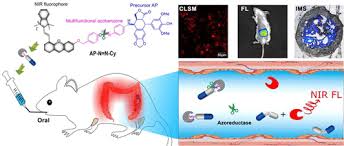Cancer is a major disease that threatens human life and health, and drug therapy (chemotherapy) is one of the effective means to treat cancer. In order to further improve the efficacy and reduce toxic and side effects, the targeted delivery and precise release of anti-cancer drugs have become an important content of anti-cancer drug development. However, how to accurately trace the delivery process, targeted drug release process, and biodistribution and metabolism of anticancer drugs in real-time and online is a difficult and core problem that urgently needs to be resolved by analytical science.

The team of Yanping Shi, a researcher at the Lanzhou Institute of Chemical Physics, Chinese Academy of Sciences, recently used multi-mode imaging analysis technology combining fluorescence imaging and mass spectrometry imaging to successfully achieve real-time accurate tracing of the whole process a new type prodrug targeting delivery, release, distribution, and metabolism of the colorectal.
The researchers designed and synthesized a new type of azo prodrug AP-N=N-Cy, which consists of a prodrug molecule (AP) through a multifunctional azophenyl group and near-infrared fluorophore (Cy) are connected together. The research results show that the azo-based prodrug can not only be used as a near-infrared probe that responds to azo reductase to track the drug delivery process in real-time, but also can be used as a delivery platform for anticancer drug molecules (AdP). In the presence of azo reductase, the multifunctional azo phenyl group in AP-N=N-Cy will be broken to release AdP and Cy. Its azo phenyl group acts as a switch to turn on Cy fluorescence. The introduction gives the azo-based prodrug a unique fluorescent on-off characteristic. Based on the specific secretion of azo reductase in the colon, the azo prodrug achieves specific localized delivery and targeted release in the colon.
The azo-based prodrug can be taken orally, and has high stability and low toxicity before reaching the colon. In view of the synchronization between the release of anticancer drug molecules and the fluorescence opening process, fluorescence imaging methods can be used to accurately trace the delivery of anticancer drug molecules in vitro, in Vitor, and in vivo, and mass spectrometry imaging can be used to precise analyze AdP and Cy at the molecular level of biological distribution in different tissues.